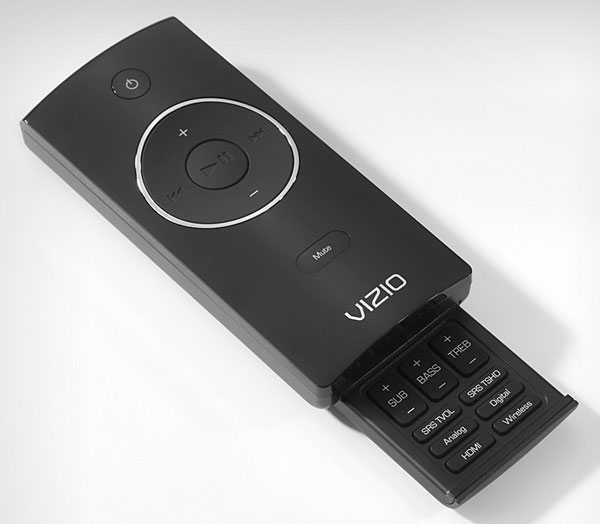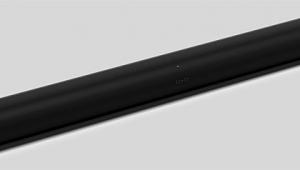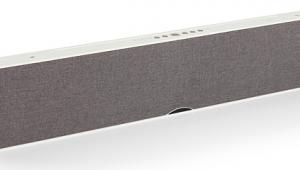I'm in the market for a soundbar. I like the review for this one and the Zvox Audio Z-Base 580 Soundbar. Scott recently talked favorably about the AudioSource S3D60 Soundbar on his podcast. The three may be considered in the "budget" price level. How do they compare in sound?
Vizio VHT215 Soundbar Page 2
To be fair, the FiOS remote is a 2-layer model intended to control the FiOS STB and a TV, not a full-fledged universal model with a separate control layer for audio components. There's also never been any guarantee that a given pre-programmed remote will support every new product that comes along.
On the other hand, there are ways to get around compatibility issues and allow soundbar users to continue to operate their systems using their familiar TV or STB remote. At least two other manufacturers—including Polk Audio and Zvox, whose Z-Base 580 I recently reviewed—offer models that are capable of learning commands from any remote. If that's not enough, the Zvox can also be set up to respond to the volume and mute commands of five leading TV brands simultaneously, some or all of which are virtually guaranteed to be supported by even the meanest pre-programmed TV or STB remote. In a similar vein, Vizio could provide compatibility with the over 14-million FiOS STB remotes currently found in U.S. households simply by enabling its soundbars to respond to Vizio TV commands!

Another solution to the volume-control problem is available if your TV has HDMI 1.4 inputs and implements a feature called Audio Return Channel (ARC). In this case, you would connect the HDMI output from the STB to the HDMI input of the VHT215 and the HDMI output from the soundbar to the HDMI input of the TV. ARC sends the audio back to the soundbar along the HDMI cable from the TV's input, and the volume can be controlled by the TV's own volume commands.
Performance
Like Commander Scott, Vizio is also unable to change the laws of physics. And while the soundbar form factor is perfectly logical for its intended application (as Mr. Spock might say), it does demand a lot of acoustic trade-offs and compromises.
Yet, despite the constraints dictated by its narrow, shallow, one-piece cabinet, the Vizio VHT215 manages to deliver solid, high-quality sound. First and foremost, dialog is well articulated and intelligible—once the Vizio went up in our master bedroom, my sweet wife no longer had to periodically interrupt shows with a "What?" and a request to replay missed snippets of dialog.
The Vizio's overall sound is much more dynamic and emotionally involving than the built-in sound of our Dell 37-inch LCD, even though this aging but still viable set has good-sized, forward-firing speakers that produce among the best built-in audio of any flat-panel TV I've heard. Having the Vizio in our master bedroom turned the room into a secondary theater, enabling us to enjoy programs there that we might previously have reserved for viewing only in our main downstairs theater.
The wonderful PBS mini-series Downton Abbey is a perfect case in point. Thanks to the Vizio soundbar, we had no problem understanding all of the diverse and sometimes difficult accents of the huge cast, and John Lunn's sumptuous score worked its magic and swept us away into the show's minutely depicted Edwardian world.
Just the other day, I was idly flipping through channels while getting dressed, when I stumbled across AMC's 30th Anniversary broadcast of Blade Runner, one of my all-time favorite movies. The scene happened to be the one where Deckard (Harrison Ford) is having lunch at a noodle stand in a bustling, rainy, neon-lit street of a future L.A. gone bad, while a garishly illuminated advertising blimp passes by overhead, loudspeakers blasting out the benefits of "A new life in the off-world colonies!"
As I stood there transfixed, socks dangling from my hands, Vangelis' glorious synthesized soundtrack swelled and I realized I was hearing a huge soundstage that seemed to extend beyond the confines of soundbar and—yes—wrap all the way around me. It was the single most effective demonstration of virtual surround I've ever heard. It seems I had happened upon a sweet spot in the room, where the VHT215's SRS TruSurround was at its best. In my case, that spot was about four or five feet back, with my ears only a few inches above the speakers' axis. The surround effect was much less dramatic further back in the room, where we usually sit, but the front soundstage still seemed wider than you'd expect. If Spock heard this with his pointy ears, he might lift an eyebrow and say, "Fascinating."
Just moments after stumbling into the surround sweet spot, my attention was distracted by a disturbing boom coming from the floor to my left—it was the subwoofer pushing its little 6.5-inch driver to the max in an attempt to smoothly reproduce and integrate the constant, very low-frequency rumble that underpins the action with the upper frequencies coming from the soundbar.

Although Vizio claims a crossover point of 108Hz, compared to "between 168 and 198Hz on competing soundbars," this is still too high to create a seamless, non-localizable transition between the (relatively high) low end of the tiny midrange drivers and the subwoofer. Simply put, the Vizio's little ported sub tends to boom and make its presence known, which in my experience is a simple fact of life with any speaker system—regardless of it's price or configuration—that pairs small, limited-low-range satellites with an outboard sub crossed over anywhere above 80-85Hz. The boom is particularly noticeable on deep male voices, which have an unfortunate tendency to straddle subwoofer crossover points in the 100-150Hz range.
Things can be smoothed out a bit by careful placement, but few rooms allow you to put a sub just anywhere you want. In my room, the smoothest blend was achieved when the sub was placed right smack in the middle of the main walkway. That's obviously not going to happen, so I compromised by turning the sub level down, which helped to tame (but not totally eliminate) the boom at the cost of a slight reduction in system's overall low-frequency impact.
Now, I want to emphasize that this is audiophile nit-picking—all things considered, the Vizio's bass is quite good, and certainly on a par with other, similar products. Imagine how good it could be if only those pesky physical laws could be suspended! But for now at least, we'll have to leave that to the realm of science fiction.
Bottom Line The Vizio VHT215 2.1-channel soundbar delivers good sound that's a significant step up from the feeble audio coming out of the compromised built-in speakers employed in most modern ultra-thin TVs. Its SRS virtual-surround function turned out to be surprisingly effective, too. The wireless subwoofer is easy to use and delivers ample bass, though it can be a struggle to get a natural-sounding match between the sub and the soundbar with this or any other similarly configured system. Setup is quick and painless, with plenty of connection options. The soundbar is particularly easy to wall mount, but I'd check for compatibility with your existing TV or STB remote before drilling any holes. Live long and prosper!
- Log in or register to post comments



Thanks for the quick reply. I look forward to your podcast and reviews.
Current setup: LG 32LE5300, PS3, Sony HT-CT100, Harmony 700
My new HDTV is creating the challenge in a good way;
I bought a Panasonic 60ST30 to replace my LG a month ago (based on the reviews here) and love it. The challenge is 3D. I don't think the HT-CT100 will switch 3D content, so I'm looking for a new soundbar.
The Zvox will handle my ~100lb 60ST30, but it is $300 more than the AudioSource and $200 more than the Vizio. I'm sure any of these sound better than my HT-CT100, but by how much?

Hi. Well I have looked for hours trying to find a place in Toronto, Canada that sells this unit without luck. Not even any trusted online stores. I have looked and tried everyone.
Since you have more resources/contact, is there anyway to find out if this item is sold in Canada and if so where?
I doubt you can help, but I had to try as I am out of all options. Thank you.




































































